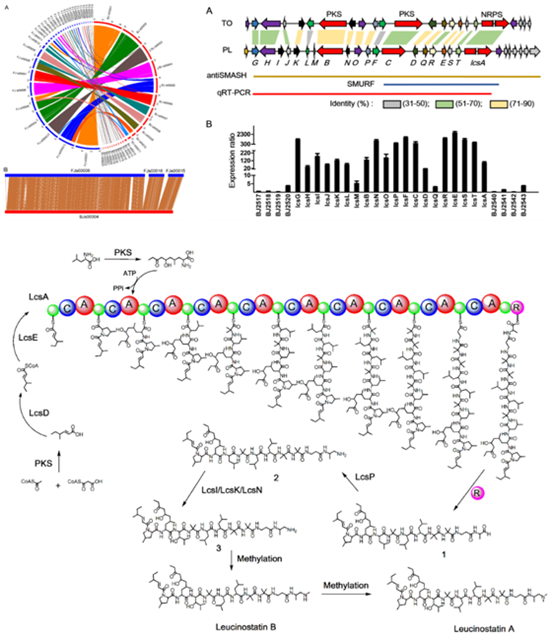PLoS Pathogens:农科院蔬菜所谢丙炎研究组等介绍脂肽抗生素生物合
2016年7月14日,国际微生物学知名期刊《PLOS Pathogens》在线发表了中国农业科学院蔬菜花卉研究所谢丙炎研究员领衔的蔬菜病害防控创新团队与中国科学院微生物研究所应文斌研究组合作的一篇研究论文,研究报道了在淡紫拟青霉生物防治作用机制的研究重要突破,研究人员解析出了淡紫拟青霉中最重要的脂肽类抗生素leucinostatins的生物合成途径,王刚、刘志国和林润茂三位博士为论文第一作者,谢丙炎研究员和尹文兵研究员为文章通讯作者。
据介绍,淡紫拟青霉是农业上重要的生物防治真菌,对于植物线虫和多种病虫害具有高效生防作用,次级代谢产物是生物防治中重要的活性因子。上世纪70年代日本科学家从淡紫拟青霉发酵液中分离到一种最重要的脂肽类抗生素leucinostatins,至今为止,对于其生物合成基因簇及调控机制尚未阐明。
该研究首先对两个淡紫拟青霉菌株进行基因组测序,通过比较基因组学分析,揭示了淡紫拟青霉基因组的一般特征;基于全基因组次级代谢产物合成基因分析结合候选基因的分子遗传敲除,确定了leucinostatins的生物合成基因簇,解析了其生物合成途径,并证明簇内转录因子的过表达使leucinostatins的产量提高1.5倍;并发现淡紫拟青霉leucinostatins除具有杀线虫活性外,对马铃薯晚疫病菌也具有抑制活性。


图脂肽抗生素生物合成途径。
原文链接:
Biosynthesis of antibiotic Leucinostatins in Bio-control FungusPurpureocillium lilacinum and Their Inhibition on PhytophthoraRevealed by Genome Mining
原文摘要:
Purpureocillium lilacinum of Ophiocordycipitaceae is one of the most promising and commercialized agents for controlling plant parasitic nematodes, as well as other insects and plant pathogens. However, how the fungus functions at the molecular level remains unknown. Here, we sequenced two isolates (PLBJ-1 and PLFJ-1) of P. lilacinum from different places Beijing and Fujian. Genomic analysis showed high synteny of the two isolates, and the phylogenetic analysis indicated they were most related to the insect pathogen Tolypocladium inflatum. A comparison with other species revealed that this fungus was enriched in carbohydrate-active enzymes (CAZymes), proteases and pathogenesis related genes. Whole genome search revealed a rich repertoire of secondary metabolites (SMs) encoding genes. The non-ribosomal peptide synthetase LcsA, which is comprised of ten C-A-PCP modules, was identified as the core biosynthetic gene of lipopeptide leucinostatins, which was specific to P.lilacinum and T. ophioglossoides, as confirmed by phylogenetic analysis. Furthermore, gene expression level was analyzed when PLBJ-1 was grown in leucinostatin-inducing and non-inducing medium, and 20 genes involved in the biosynthesis of leucionostatins were identified. Disruption mutants allowed us to propose a putative biosynthetic pathway of leucinostatin A. Moreover, overexpression of the transcription factor lcsF increased the production (1.5-fold) of leucinostatins A and B compared to wild type. Bioassays explored a new bioactivity of leucinostatins and P. lilacinum: inhibiting the growth of Phytophthora infestans and P. capsici. These results contribute to our understanding of the biosynthetic mechanism of leucinostatins and may allow us to utilize P. lilacinum better as bio-control agent.
doi:10.1371/journal.ppat.1005685
作者:谢丙炎

